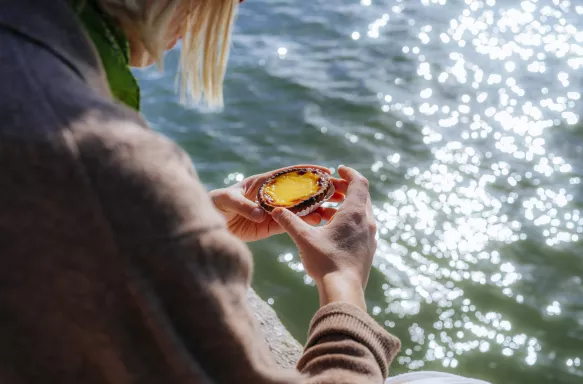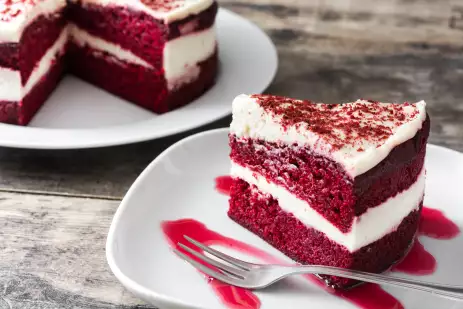13 Famous Cakes from Around the World

Let’s be honest, cake isn’t just dessert. It’s a universal sign of celebration, indulgence, and, in some cases, a well-deserved reward when you simply want to spoil yourself at the end of a long day. While the basics - flour, sugar, eggs, and butter – often remain constants, cultural traditions, local ingredients, and techniques give cakes their distinctive character from country to country. But cakes go beyond the ubiquitous birthday sponge; each country brings its own unique twist to the world of cake, and what better way to explore global culture than through layers of buttercream and chocolate ganache! From refined French pâtisserie to Indian aromatic spiced cakes, these sweet treats are a delicious window into the world’s culinary traditions, so let us take you on the sweetest journey around the globe as we explore some of the world’s most famous bakes.

1. Italy: Torta Caprese
Italy’s Torta Caprese is a flourless chocolate cake originating from the island of Capri. Made simply with almond meal, butter, eggs, sugar, and dark chocolate, this cake is a dream for lovers of the rich combination of chocolate and almonds. With its crisp exterior and moist, dense interior, Torta Caprese is often dusted with icing sugar and served with a scoop of gelato or whipped cream. Gluten-free, its origins are said to be the result of a happy culinary accident, when a baker forgot to add flour to the mix, creating the luscious texture that we know today. When it comes to this cake, less is definitely more.

2. Austria: Sachertorte
You can’t talk about cake without paying homage to Austria's iconic Sachertorte. This chocolatey apricot wonder has been wowing cake lovers since 1832, when Franz Sacher first whipped it up for Prince Metternich. The dense chocolate sponge is subtly sweetened with a layer of apricot jam, then covered in a shiny, dark chocolate glaze. Traditionally served with whipped cream, the Sachertorte is a symbol of Vienna’s refined café culture and is still served at the renowned Hotel Sacher, where its secret recipe is fiercely guarded. One bite and you’ll understand why this Viennese classic has such staying power.

3. New Zealand: Pavlova
The Pavlova, a light and airy meringue-based dessert, is a source of national pride for New Zealand (and hotly contested by Australia). Named after the Russian ballerina Anna Pavlova, who visited New Zealand in the 1920s, this cloud-like showstopper is known for its crisp crust and soft, marshmallow-like centre. It’s typically topped with cream and fresh kiwifruit, strawberries, or passionfruit. The Pavlova’s lightness and simplicity make it a staple for summer celebrations, (especially around the southern hemisphere’s Christmas) when it’s often seen gracing family tables as a refreshing, fruity dessert.

4. Australia: Lamington
Imagine cubes of soft sponge cake dipped in chocolate, then rolled in desiccated coconut. That’s Australia’s quintessential cake, the modest Lamington. It’s simple, it’s messy, but packed with flavour, it’s utterly delicious. Some versions come with a jam or cream filling, but the classic Lamington - named after Lord Lamington, a former governor of Queensland is pure, unfussy indulgence.

5. India: Mawa Cake
If you’ve never had a mawa cake, you’re missing out on one of India’s best-kept secrets. A fusion of Persian and Indian baking traditions, this spiced cake, popular in Mumbai’s Irani cafés, is made from mawa - reduced milk solids - and flavoured with aromatic cardamom. A few slivers of pistachio or almond sprinkled on top adds a little exotic flair. Sophisticated yet comforting, put the world to rights over a slice of mawa cake and a steaming cup of chai.

6. Japan: Kasutera
Japan’s castella cake, known locally as kasutera, is a soft, honey-flavoured sponge cake that was introduced by Portuguese merchants in the 16th century. Over time, it became a staple in Japanese confectionery and a favourite teatime treat, particularly in Nagasaki. Made with simple ingredients - sugar, flour, eggs, and honey, it’s light, fluffy, and subtly sweet, making it the perfect companion to a cup of green tea. You’ll often find it sold in beautiful packaging, perfect as a souvenir or gift.

7. USA: Red Velvet Cake
What could be more American than apple pie? Well, how about some red velvet sponge. Few cakes make as dramatic an entrance as this sweet treat, with its bold, scarlet hue and thick cream cheese icing. The origins of this American classic are debated, but its popularity skyrocketed in the mid-20th century, when food colouring became more widely available. What started as a slightly tangy, cocoa-flavoured cake has since become a must-have at weddings, birthdays, and any celebration that requires something visually stunning!

8. Germany: Schwarzwälder Kirschtorte
Not just the UK dessert of choice in the 80s, Black Forest gateau is Germany’s most famed cake. This towering confection is made of layers of chocolate sponge, whipped cream, cherries, and Kirschwasser (cherry brandy), all topped with chocolate shavings and more cherries. Rich, dramatic, and unapologetically indulgent, it hails from the Black Forest region, where cherries and brandy are local treasures and is as much a feast for the eyes as it is for the palate!

9. Croatia: Kremšnita
Practically a national treasure, akin to our very own custard slice, picture flaky pastry sandwiching a mountain of custard so thick, you’ll wonder if it’s defying gravity. Topped with icing sugar, the Kremšnita is light yet indulgent, and trying to eat it without wearing half of it is part of the experience. Locals take their Kremšnita seriously: pair it with a strong coffee and prepare for a dessert that’s deliciously moreish.

10. Greece: Revani
Revani, a semolina-based cake soaked in syrup, is a traditional Greek dessert that’s a perfect balance of sweetness and texture. Light, yet satisfyingly dense, thanks to the use of semolina, it’s often flavoured with orange or lemon zest, giving it a fresh, vibrant taste. After baking, the cake is soaked in a fragrant sugar syrup, made with rose water or cinnamon, which deliciously infuses this super-moist sponge. A common sight at Greek festivals and family gatherings, revani is a traditional Greek staple.

11. Portugal: Pastel de Nata
Technically more of a custard tart than a cake, but who are we to argue with a pastry that has its own secret recipe locked away in a monastery? The pastel de nata was created by monks in Lisbon’s Jerónimos Monastery; eggs, sugar, and puff pastry – plus a touch of divine inspiration perhaps – created the golden, caramelised masterpiece we know and love. The best place to enjoy these legendary treats is in the Portuguese capital’s Pastéis de Belém, the shop that still uses the original secret recipe. Fair warning, one is never enough.

12. France: Madeleine
This dainty shell-shaped sponge was immortalised by the great French writer Marcel Proust in his famous novel ‘In Search of Lost Time’. On biting into a madeleine dipped in tea, a flood of childhood memories comes unexpectedly rushing back – turning the humble madeleine into one of literature’s most famous symbols of memory and nostalgia. Few people know that this classic French snack, made from a simple batter of flour, butter, eggs, sugar, and a hint of lemon zest, in fact has Polish origins. Baked golden-brown with a perfect crisp edge, the real magic of the madeleine is in its simplicity. Feeling French? Dip it into your morning café au lait and enjoy!

13. Poland: Sernik
Let’s end our cake journey in Eastern Europe with Poland’s beloved sernik. This Polish cheesecake is made with twaróg, a fresh, curd-like cheese that gives it a unique, slightly tangy flavour. Sernik can be baked or unbaked and comes in various forms - sometimes studded with raisins, topped with chocolate icing, or a swirl of fruity jam. As deeply rooted in Polish tradition as the Sunday family dinner, the best place to savour an authentic slice of sernik is in Kraków’s cosy cafes or during the festive Easter season, when Polish families bake this cake to celebrate.